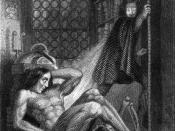by n KALSI
Discuss the theme of suffering in Mary Shelly's 'Frankenstein' and P.B.Shelly's 'Alastor: Or the spirit of solitude'.
The theme of suffering is best conveyed through the "solitary" aesthetic figure of the wanderer or vagrant. Romantic writers produced works revealing extremes of isolation and socialisation, creating 'either a wild beast or a god' and proving that although solitude can render knowledge, it can also be the cause of deep suffering. Mary Shelley's Frankenstein,
is an account of the monstrous potentiality of human creative power when severed from moral and social concerns. Suffering is displayed through the characters of Victor Frankenstein and his nameless creation, the monster or "the fallen angel" . Moreover, what is necessary to further the discussion of suffering, is the cause and indeed expression of suffering endured by the central characters. Frankenstein hopes to be the source of a new species, but ironically, his creature evolves into a self acknowledged Satan who swears eternal revenge and war on upon his creator and all the human race as a result of the misery he experiences at their hands.
The Monster sees salvation only through the creation of his Eve. Both master and creature are torn by their internal conflicts from misapplied knowledge and their sense of isolation. P.B. Shelley's Alastor; or the Spirit of Solitude, compares well to Frankenstein as there are many similarities with the poet and the character of the Monster and his creator, Frankenstein; both texts portray the themes of suffering through isolation and central to both is the desire for a companion or equal other.
Alastor; or the Spirit of Solitude is a touching poem which conveys well the suffering of the individual. There is an obsession within the young poet within the poem, which leads him to express the...


